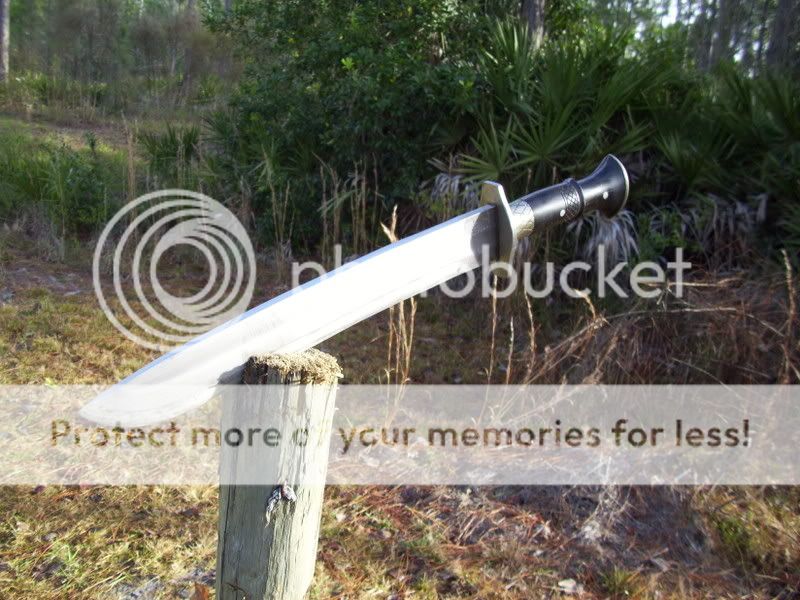Ankerson
Knife and Computer Geek
- Joined
- Nov 2, 2002
- Messages
- 21,094
This is a chop off between the Busse NMFBM, FFBM and Himalayan Imports 18 AK, I took my largest 3 choppers that I use and put them against each other to see which one would come out on top. All 3 knives did very well as you will see when you watch the videos.
Specs are as Follows:
NMFBM:
11.5 Blade
17.5 OAL
.25 Thick
31.5 ounces
FFBM
10 Blade
16 OAL
.3125 Thick
32 Ounces
18 AK
12.25 Blade
18 OAL
.500 Thick
About 40 Ounces, Not sure exactly, but its heavy.
Part 1
[youtube]<object width="560" height="340"><param name="movie" value="http://www.youtube.com/v/VLn3ohuqbeo&hl=en_US&fs=1&"></param><param name="allowFullScreen" value="true"></param><param name="allowscriptaccess" value="always"></param><embed src="http://www.youtube.com/v/VLn3ohuqbeo&hl=en_US&fs=1&" type="application/x-shockwave-flash" allowscriptaccess="always" allowfullscreen="true" width="560" height="340"></embed></object>[/youtube]
Part 2
[youtube]<object width="560" height="340"><param name="movie" value="http://www.youtube.com/v/aNHbS9R8yuE&hl=en_US&fs=1&"></param><param name="allowFullScreen" value="true"></param><param name="allowscriptaccess" value="always"></param><embed src="http://www.youtube.com/v/aNHbS9R8yuE&hl=en_US&fs=1&" type="application/x-shockwave-flash" allowscriptaccess="always" allowfullscreen="true" width="560" height="340"></embed></object>[/youtube]
Part 3, Wrap up
[youtube]<object width="560" height="340"><param name="movie" value="http://www.youtube.com/v/f_WRZ6kj0Ws&hl=en_US&fs=1&"></param><param name="allowFullScreen" value="true"></param><param name="allowscriptaccess" value="always"></param><embed src="http://www.youtube.com/v/f_WRZ6kj0Ws&hl=en_US&fs=1&" type="application/x-shockwave-flash" allowscriptaccess="always" allowfullscreen="true" width="560" height="340"></embed></object>[/youtube]
Specs are as Follows:
NMFBM:
11.5 Blade
17.5 OAL
.25 Thick
31.5 ounces
FFBM
10 Blade
16 OAL
.3125 Thick
32 Ounces
18 AK
12.25 Blade
18 OAL
.500 Thick
About 40 Ounces, Not sure exactly, but its heavy.
Part 1
[youtube]<object width="560" height="340"><param name="movie" value="http://www.youtube.com/v/VLn3ohuqbeo&hl=en_US&fs=1&"></param><param name="allowFullScreen" value="true"></param><param name="allowscriptaccess" value="always"></param><embed src="http://www.youtube.com/v/VLn3ohuqbeo&hl=en_US&fs=1&" type="application/x-shockwave-flash" allowscriptaccess="always" allowfullscreen="true" width="560" height="340"></embed></object>[/youtube]
Part 2
[youtube]<object width="560" height="340"><param name="movie" value="http://www.youtube.com/v/aNHbS9R8yuE&hl=en_US&fs=1&"></param><param name="allowFullScreen" value="true"></param><param name="allowscriptaccess" value="always"></param><embed src="http://www.youtube.com/v/aNHbS9R8yuE&hl=en_US&fs=1&" type="application/x-shockwave-flash" allowscriptaccess="always" allowfullscreen="true" width="560" height="340"></embed></object>[/youtube]
Part 3, Wrap up
[youtube]<object width="560" height="340"><param name="movie" value="http://www.youtube.com/v/f_WRZ6kj0Ws&hl=en_US&fs=1&"></param><param name="allowFullScreen" value="true"></param><param name="allowscriptaccess" value="always"></param><embed src="http://www.youtube.com/v/f_WRZ6kj0Ws&hl=en_US&fs=1&" type="application/x-shockwave-flash" allowscriptaccess="always" allowfullscreen="true" width="560" height="340"></embed></object>[/youtube]

